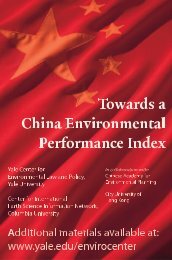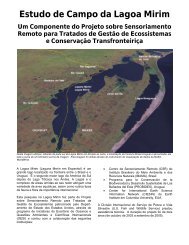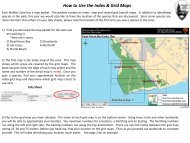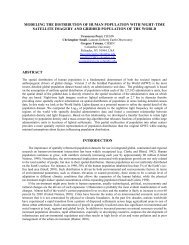In Search of Shelter - Center for International Earth Science ...
In Search of Shelter - Center for International Earth Science ...
In Search of Shelter - Center for International Earth Science ...
Create successful ePaper yourself
Turn your PDF publications into a flip-book with our unique Google optimized e-Paper software.
End Notes1 For rights-based approach see Kolmannskog, V. 2009. Dignity indisasters and displacement —exploring law, policy and practice onrelocation and return in the context <strong>of</strong> climate change. Paper prepared<strong>for</strong> the GECHS Synthesis Conference, “Human Security in an Era <strong>of</strong>Global Change,” June 22-24, 2009, University <strong>of</strong> Oslo, Norway. <strong>In</strong>relation to the use <strong>of</strong> the term “resettlement” in this report, it is notrestricted to the meaning it has assumed in refugee law and policy.2 Solomon, S., D. Qin, M. Manning, R.B. Alley, T. Berntsen, N.L.Bind<strong>of</strong>f, Z. Chen, et al. 2007. Technical summary. <strong>In</strong> Solomon, S., D.Qin, M. Manning, Z. Chen, M. Marquis K. B. Averyt, M. Tignor, andH. L. Miller, eds., Climate Change 2007: The Physical <strong>Science</strong> Basis.Contribution <strong>of</strong> Working Group I to the Fourth Assessment Report <strong>of</strong>the <strong>In</strong>tergovernmental Panel on Climate Change. Cambridge: CambridgeUniversity Press.3 These case studies result from fieldwork in which expert interviews,a survey <strong>of</strong> migrants, and a related survey <strong>of</strong> non-migrants living inareas with documented environmental degradation were carried out byresearchers within the framework <strong>of</strong> the European Commission project“Environmental Change and Forced Migration Scenarios” (EACH-FOR),and in cooperation with the <strong>In</strong>ternational Organization <strong>for</strong> Migration(IOM). The cases provide an evidence-based analysis <strong>of</strong> the challengesposed by climate change to human security and migration. http://www.each-<strong>for</strong>.eu/index.php?module=main.4 Warner, K., T. Afifi, O. Dun, M. Stal, S. Schmidl and J. Bogardi. 2008.Human security, climate change, and environmentally induced migration.<strong>In</strong> Climate Change: Addressing the Impact on Human Security. PolicyPaper. Athens: Hellenic Ministry <strong>of</strong> Foreign Affairs, Human SecurityNetwork Greek Chairmanship 2007-2008.5 Bachh<strong>of</strong>en, C. 2009. Personal communication. Social DevelopmentDepartment, World Bank.6 Jiang, W.M., and Y. Chen. 2008. The impact <strong>of</strong> anthropogenic heat onurban boundary layer structures. Chinese Journal <strong>of</strong> Atmospheric <strong>Science</strong>s31 (1): 37-47.7 McGranahan, G., D. Balk, and B. Anderson. 2007. The rising tide:Assessing the risks <strong>of</strong> climate change and human settlements in lowelevation coastal zones. Environment & Urbanization, 19 (1):17–37.8 Afifi, T., and K. Warner. 2008. The impact <strong>of</strong> environmental degradationon migration flows across countries. Working Paper No.5/2008, UNU-EHS Working Paper Series, United Nations University, <strong>In</strong>stitute <strong>for</strong>Environment and Human Security. Bonn.9 Afifi, T. 2009. Case study report on Niger <strong>for</strong> the Environmental Changeand Forced Migration Scenarios Project. http://www.each-<strong>for</strong>.eu/.10 Bogardi, J., and K. Warner. 2009. Here comes the flood. Nature ReportsClimate Change 3 (January): 9-11. doi.10.1038/climate.2008.138.11 Myers, N. 2001. Environmental refugees: A growing phenomenon <strong>of</strong> the21st century. Philosophical Transactions <strong>of</strong> the Royal Society B 357:609-613. doi 10.1098/rstb.2001.09532212 Christian Aid. 2007. Human tide: The real migration crisis. Christian AidReport. London. http://www.christianaid.org.uk/Images/human-tide.pdf.13 Brown, Oli. 2008. Migration and Climate Change. <strong>In</strong>ternationalOrganization <strong>for</strong> Migration (IOM): Research Series No. 31. Geneva: IOM.14 Castles, S. 2002. Environmental change and <strong>for</strong>ced migration: Makingsense <strong>of</strong> the debate. New Issues in Refugee Research, Working Paper No.70, United Nations High Commissioner <strong>for</strong> Refugees (UNHCR), Geneva;Dun, O. and F. Gemenne. 2008. Defining environmental migration. ForcedMigration Review 31:10-11.15 See <strong>for</strong> example Hugo, G. 1996. Environmental concerns and internationalmigration. <strong>In</strong>ternational Migration Review 30:105-131. See also Renaud,F.G., J.J. Bogardi, O. Dun, and K. Warner. 2007. Control, adapt or flee: Howto face environmental migration? <strong>In</strong>terSecTions, Publications Series <strong>of</strong>UNU-EHS, no. 5/2007, Bonn. See also Renaud, F.G., O. Dun, K. Warner, andJ.J. Bogardi. (under review). Deciphering the importance <strong>of</strong> environmentalfactors in human migration. <strong>In</strong>ternational Migration, special edition onEnvironmental Change, Social Vulnerability, and Forced Migration.16 Dun and Gemenne 2008. See note 14 above.17 Black, R. 2001. Environmental refugees: Myth or reality? New Issuesin Refugee Research, Working Paper No. 34, University <strong>of</strong> Sussex,Brighton. http://www.jha.ac/articles/u034.pdf; McNamara, K.E. 2007.Conceptualizing discourses on environmental refugees at the UnitedNations. Population and Environment 29(1): 12-24.18 <strong>In</strong>ternational Organisation <strong>for</strong> Migration (IOM). 2007. Discussion note:migration and the environment. <strong>In</strong>ternational Organization <strong>for</strong> Migration,Geneva. 14 February 2008, 1. http://www.iom.int/jahia/webdav/shared/shared/mainsite/about_iom/en/council/94/MC_INF_288.pdf.19 The IPCC Fourth Assessment Report found that there were 680documented studies <strong>of</strong> the cryosphere that showed a statisticallysignificant ice retreat consistent with warming trends. See Rosenzweig,C., D. Karoly, V. Vicarelli, P. Ne<strong>of</strong>otis, Q. Wu, G. Casassa, A. Menzel, etal. 2008. Attributing physical and biological impacts to anthropogenicclimate change. Nature 453 (May): 353-357. DOI:10.1038/nature06937.20 <strong>In</strong> one Himalayan catchment, glaciers were found to contribute 87percent <strong>of</strong> run<strong>of</strong>f while rainfall provided only 13 percent. See Singh,P., A. Manohar, and N.K. Goel. 2006. Effect <strong>of</strong> climate change on run<strong>of</strong>f<strong>of</strong> a glacierized Himalayan basin. Hydrological processes 20 (9): 1979-1992.21 According to Singh et al. 2006 (see note 20 above), a temperature rise<strong>of</strong> 2 degrees Celsius results in an increase in run<strong>of</strong>f <strong>of</strong> 28 percent overthe short-term.22 Castro, M., A. de Sherbinin, and S. Vajhalla. 2009. Populationdisplacements associated with environmentally significant infrastructureprojects. A presentation at the 2009 IHDP Open Meeting, 26–30 April,Bonn. http://www.populationenvironmentresearch.org/workshops.jsp.23 UNEP-GRID Arendal Map Gallery. Available at http://maps.grida.no/go/graphic/water-towers-<strong>of</strong>-asia-glaciers-water-and-population-in-thegreater-himalayas-hindu-kush-tien-shan-tib.24 Kehrwald, N., L. Thompson, Y. Tandong, E. Mosley-Thompson, U.Schotterer, V. Alfimov, J. Beer, J. Eikenberg, and M. Davis. 2008. Massloss on Himalayan glacier endangers water resources. GeophysicalResearch Letters 35 (22). DOI:10.1029/2008GL035556; and WWF NepalProgram. 2005. An Overview <strong>of</strong> Glaciers, Glacier Retreat, and SubsequentImpacts in Nepal, <strong>In</strong>dia and China. http://assets.panda.org/downloads/himalayaglaciersreport2005.pdf25 Centre <strong>for</strong> Ethnic and Migration Studies (CEDEM). 2009. Forced migrationand the Three Gorges Dam. Case study report on China <strong>for</strong> the EnvironmentalChange and Forced Migration Scenarios Project. http://www.each-<strong>for</strong>.eu/.26 Vorosmarty, C., J. Syvitski, J. Day, A. de Sherbinin, L. Giosan, and C.Paola. 2009. Battling to save the world’s river deltas. Bulletin <strong>of</strong> theAtomic Scientists (March/April): 31-43.27 BookRags. http://www.bookrags.com/research/ganges-river-eorl-05/.28 Jäger, J., J. Frühmann, S. Grünberger, and A. Vag. 2009. D.3.4 SynthesisReport. Environmental Change and Forced Migration ScenariosProject, 64-66. http://www.each-<strong>for</strong>.eu/documents/EACH-FOR_Synthesis_Report_090515.pdf.29 Water scarcity may eventually effect urban industries and evenhouseholds, though the amount <strong>of</strong> water used <strong>for</strong> industrial and domesticuses is a fraction <strong>of</strong> agricultural use, especially in relatively arid regionssuch as Pakistan.30 Periodic flooding <strong>of</strong> the Yangtze has caused major disasters. Flooding<strong>of</strong> the Yangtze in 1998 resulted in major population displacements andsome 3,000 deaths in and around Shanghai. See de Sherbinin, A., A.Schiller, and A. Pulsipher. 2007. The vulnerability <strong>of</strong> global cities toclimate hazards. Environment & Urbanization 19 (1): 39-64.31 Estimated water use efficiencies are only 50 percent in many Asiancountries. For example, the 11th Five-Year Plan in China set as atarget the increase in water use efficiency <strong>for</strong> irrigated agriculturefrom 45 percent to 50 percent. See National Development and Re<strong>for</strong>mCommission, Ministry <strong>of</strong> Water Resources, Ministry <strong>of</strong> Housing andUrban-Rural Development. 2006. Eleventh Five-Year Plan <strong>for</strong> NationalWater Resources Development. http://www.sdpc.gov.cn/zcfb/zcfbtz/2007tongzhi/W020070607490857858318.pdf.32 Ortiz Pérez, M., and A. Méndez Linares. 1999. Escenarios devulnerabilidad por ascenso del nível del mar en la costa mexicana delGolfo de México y el Mar Caribe. <strong>In</strong>vestigaciones Geográficas 39: 68-81. http://www.igeograf.unam.mx/instituto/publicaciones/boetin/bol39/b39art4.pdf; and Ortiz Pérez, M., and A. Méndez Linares. 2004.Vulnerabilidad al ascenso del nivel del mar y sus implicaciones enlas costas bajas del Golfo de México y el Mar Caribe. <strong>In</strong> Rivera, E.,G. Villalobos, I. Azus, and F. Rosado, eds., El Manejo Costero enMexico. Campeche: EPOMEX/UACAM, 307-320. http://www.uacam.mx/epomex/paginas/pdf/mancos/cap20.pdf.33 Nohara, D., A. Kitoh, M. Hosaka and T. Oki. 2006. Impact <strong>of</strong> climatechange on river run<strong>of</strong>f. Journal <strong>of</strong> Hydrometeorology 7:1076-1089.







